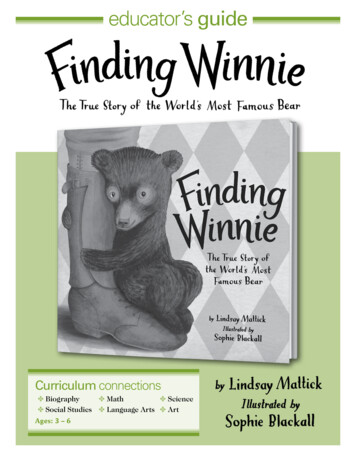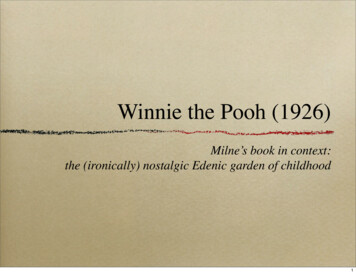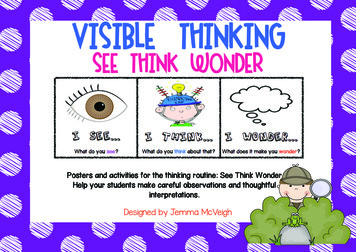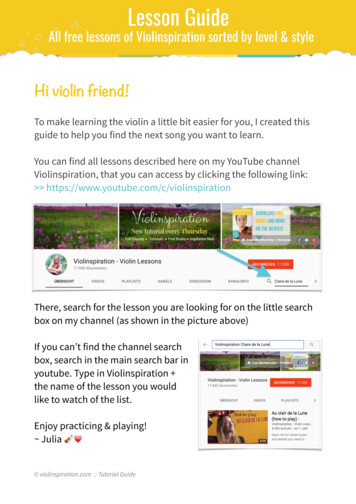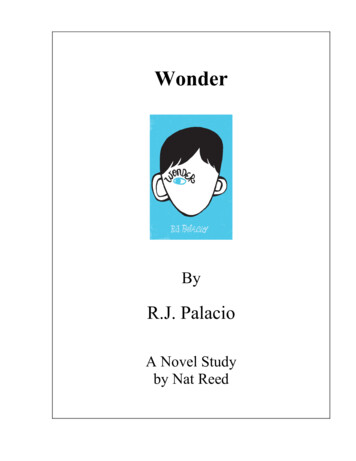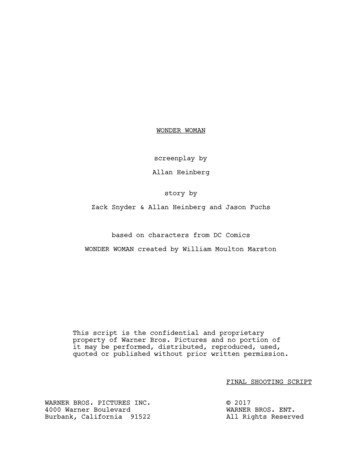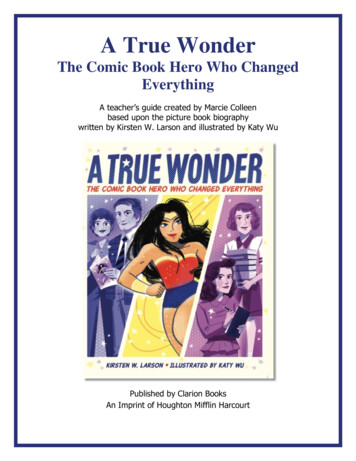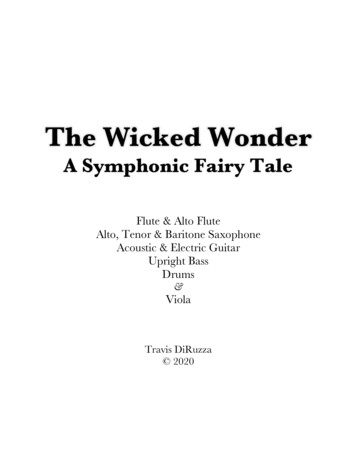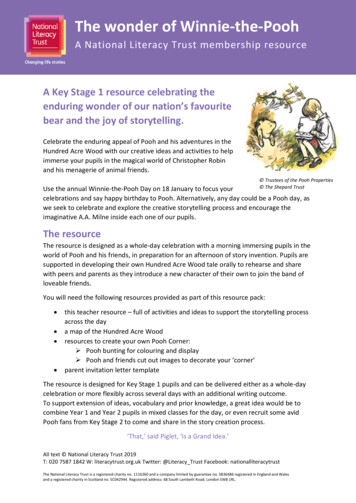
Transcription
The wonder of Winnie-the-PoohA National Literacy Trust membership resourceA Key Stage 1 resource celebrating theenduring wonder of our nation’s favouritebear and the joy of storytelling.Celebrate the enduring appeal of Pooh and his adventures in theHundred Acre Wood with our creative ideas and activities to helpimmerse your pupils in the magical world of Christopher Robinand his menagerie of animal friends. Trustees of the Pooh Properties The Shepard TrustUse the annual Winnie-the-Pooh Day on 18 January to focus yourcelebrations and say happy birthday to Pooh. Alternatively, any day could be a Pooh day, aswe seek to celebrate and explore the creative storytelling process and encourage theimaginative A.A. Milne inside each one of our pupils.The resourceThe resource is designed as a whole-day celebration with a morning immersing pupils in theworld of Pooh and his friends, in preparation for an afternoon of story invention. Pupils aresupported in developing their own Hundred Acre Wood tale orally to rehearse and sharewith peers and parents as they introduce a new character of their own to join the band ofloveable friends.You will need the following resources provided as part of this resource pack: this teacher resource – full of activities and ideas to support the storytelling processacross the daya map of the Hundred Acre Woodresources to create your own Pooh Corner: Pooh bunting for colouring and display Pooh and friends cut out images to decorate your ‘corner’parent invitation letter templateThe resource is designed for Key Stage 1 pupils and can be delivered either as a whole-daycelebration or more flexibly across several days with an additional writing outcome.To support extension of ideas, vocabulary and prior knowledge, a great idea would be tocombine Year 1 and Year 2 pupils in mixed classes for the day, or even recruit some avidPooh fans from Key Stage 2 to come and share in the story creation process.‘That,’ said Piglet, ‘is a Grand Idea.’All text National Literacy Trust 2019T: 020 7587 1842 W: literacytrust.org.uk Twitter: @Literacy Trust Facebook: nationalliteracytrustThe National Literacy Trust is a registered charity no. 1116260 and a company limited by guarantee no. 5836486 registered in England and Walesand a registered charity in Scotland no. SC042944. Registered address: 68 South Lambeth Road, London SW8 1RL.
The world of Winnie-the-PoohIn preparation for the day: Send out your parent invitation letter(provided for you to download as a worddocument to enable appropriateediting), as pupils will need to bring intheir own soft toy for the day to takecentre stage in their new invented storyjust like Pooh did for Christopher Robin.When storytelling, an audience is a greatmotivator, and inviting parents in at theend of the day to hear the createdstories and share their own Winnie-thePooh memories is a lovely way toThe original Winnie the Pooh toys. By Spictacular - Own work by thecelebrate the essence of the Pooh storyoriginal uploader., Public urid 1112066and legacy. You may also want toorganise some simple refreshments –maybe some honey biscuits to help with the celebrations! Recreate your classroom as your very own Pooh Corner using the Pooh buntingtemplates and character images. Bring the outside in with any woodland resourcesavailable. Peg leaves onto strings and bring any potential Pooh sticks or branches tocreate your own Hundred Acre Wood environment. Involving pupils in thetransformation of the classroom will build their engagement and interest ready forthe big day.Create a display of as many of the Pooh books as you can find. A comprehensive listcan be found here by Egmont, Pooh’s official brands/winnie-the-pooh/437Old versions are often intriguing for pupils, after all Pooh is almost 93 years old now!There are also with newer titles such as the marvellous Return to the Hundred AcreWood and not forgetting A.A. Milne’s poetry collections When We Were Very Youngand Now We Are Six. Ask other staff members if they have different versions todisplay or any Pooh toys to add.All text National Literacy Trust 2019
Part one: All things Pooh The following activities are designed to help pupils activate and extend their priorknowledge of the Pooh stories, and build their knowledge of both character and settingthrough paired and collaborative talk activities, in preparation for their own story inventionsbased on the originals. If you have the opportunity to work in mixed aged groups or recruitolder buddies from Key Stage 2 to work alongside younger pupils, the benefits in terms ofvocabulary, creative ideas and of course engagement is obvious, and a wonderful way tobuild a learning community. Older pupils will also no doubt have their own memories andknowledge of Pooh and his friends to share.What do you know?Organise pupils into groups of three and get them to share and discuss anything they knowat all about Winnie-the-Pooh. Prompts might include: Do they have any Pooh toys?Have they seen any videos/films?How many characters can they name?Have they ever heard any poems, songs or even ‘hums’?!Have they ever played Poohsticks?Can they remember any Pooh stories?Once they have had some time in their groups to share and pool their knowledge, organisethe whole class into one story circle. Use one of your display sticks or small branches as astory stick or select a special story stone to pass. Encourage pupils to share one thing eachwith the whole class as they pass the story stick around the circle. Additional support staffor your Key Stage 2 buddy helpers could create a mind map of all their knowledge.Character stationsSet up six character stations, one for each of the main characters: Pooh himself, Piglet, Owl,Eeyore, Tigger and Christopher Robin. You may want to use the character images suppliedto decorate your stations.For each station, have one large piece of flipchart paper and some coloured pens. Split thepupils into equal groups and rotate the groups around the stations as a carousel. At eachstation pupils are encouraged to add ideas, thoughts or knowledge they have about eachcharacter and write any words they think might describe the character. As support for theactivity, read out and then display a range of possible character words on the IWB (wise,bouncy, excited, honest, friendly, miserable, practical, etc).A useful summary of each main character can be found here for Pupils may know very little but can make predictions based on their character’s appearanceand any stereotypes they might have – for example, perhaps Owl would be the wise one.All text National Literacy Trust 2019
Time for a storyAllow pupils to get comfortable, go and get their soft toy and settle down to find even moreabout Pooh and his friends through one of his stories. We forget that one of the great thingsabout the original Pooh books, Winnie-the-Pooh and The House at Pooh Corner, is that theyare chapter books each with a separate mini story to delight. Choose one of your favouritesor allow the pupils to vote for the one they’d like most to hear. In the brilliant style ofA.A. Milne, each story helpfully has a distinct title with its own ‘ In which ’ description.It could be:Pooh Goes Visiting – In which Pooh goes visiting and gets stuck in a tight placeorSurrounded by Water – In which Piglet is entirely surrounded by waterLater stories based on the original characters but not written by Milne such as thewonderfully authentic Return to the Hundred Acre Wood also follow the same structure, aswell as shorter stories such as The Long Winter’s Sleep or Pooh’s Snowy Day from theDisney stories.Action stationsHaving now heard a story we are getting to know some of the characters even better.Encourage pupils to go back to the character stations to add any further details orinformation to their flipcharts. Discuss with pupils why it is always important when creatinga story that we know our characters really well. Introduce the idea that this afternoon theywill be making up their own stories about Pooh and his friends and that all this knowledge isgoing to help them do that well.The Hundred Acre WoodPrint out copies of the map of the Hundred Acre Wood for pupils in small groups to exploreor display on the IWB. Is there any further information they want to add to their classcharacter sheets now that they know where some of the characters live? You might want toplay the ‘A to B’ game and challenge pupils to describe different journeys, e.g. if ChristopherRobin wants to visit Pooh’s house, can you describe the route you think he would take.(Encourage use of prepositions to support them, e.g. across, through, under, around, etc.)Encourage pupils to challenge each other and answer the questions on the map.What do they notice about many of the words on the map? Which character do they thinkstruggles with their spelling?In preparation for their own stories, allow pupils individually or preferably in pairs to createtheir own versions of the Hundred Acre Wood map. They can move characters’ homes andadd as many new details as they wish – extra rivers, paths, meadows, fields, perhaps agarden, bogs and trees. Encourage them to add the details rather than colour and decoratewhich can be done as an extension or homework follow up activity later.All text National Literacy Trust 2019
Part two: Return to the Hundred Acre WoodHaving immersed pupils in the world of Pooh and his friends, we let the pupils take controland support them in their own creative storytelling and invention.The story of Winnie-the-PoohShare with pupils the legendary story of how the Pooh stories came into existence fromsuch simple origins as a father making up stories about his son’s toy animals. Explain thatjust as A.A. Milne did they are going to create new stories using their very own toys.The book’s creatorsThese stunning stories, which have become part of our heritage and are so well loved werethe creation of author A.A. Milne. Milne was an established author and playwright andregularly contributed to Punch magazine, where Pooh first made his appearance in a poemcalled ‘Teddy Bear’ which was republished in When We Were Very Young. It would be lovelyto share this poem with pupils or perhaps any of your favourite Milne poems from thispoetry book or from Now We Are Six.E.H. Shepard, who so magically brought Milne’s characters to life, was an artist and bookillustrator. He also contributed to Punch magazine as a cartoonist and was introduced toMilne through the magazine. The illustrations of Pooh were actually modelled on Shepard’sown son’s bear called Growler. You may want to encourage pupils carefully to observe anddraw their own chosen toy to illustrate their stories at a later stage. Shepard also famouslyillustrated The Wind in the Willows which you may also want to share with pupils andperhaps add to your display.Interesting facts to share The real Christopher Robin Milne received a small stuffed bear on his firstbirthday from the famous Harrods toy store in London. At first he was called Edward Bear but Christopher renamed him. The distinctivename of Winnie-the-Pooh came from a combination of the names of a real bearand a pet swan. During the 1920s there was a black bear named Winnie in theLondon Zoo who had been the mascot for the Winnipeg regiment of theCanadian army. Pooh was also the name of a swan in When We Were VeryYoung. Following Pooh came the rest of the stuffed animals, which Christopher receivedas gifts, and which he loved and played with throughout his childhood.Apparently, so did the family dog, which may have contributed to their well-wornappearance. The baby kangaroo stuffed animal (named Roo) was lost in an appleorchard during the 1930s. Winnie-the-Pooh had adventures with Piglet, Eeyore, Kanga, Roo, Owl, Rabbit,and Tigger in the Hundred Aker (or Acre) Wood, based on the Ashdown Forest insouthern England, located near the Milne family home.All text National Literacy Trust 2019
Christopher’s author father A.A. Milne and his artist friend Ernest H. Shepard decided tobring the animals to life, and the rest, so they say, is history.Every year thousands of children and their parents visit the original toys of Winnie-the-Poohand his pals, who now have a home in the New York Public Library, USA.Adapted from copy written by the New York LibrarySee images and further details of Christopher’s toys as they are today an/childrens-center-42nd-street/pooh#4And introducing In groups of three, ask pupils to show each other their chosen toys and retell the story ofhow and when they received them and why they love them. You might want to bring in oneof your own childhood toys to model the conversation and let pupils ask any questions.Share with pupils that over the years, new characters have been introduced to the stories.Lottie the Otter was introduced in Return to the Hundred Acre Wood, and in The Best Bear inAll the World, produced for Pooh’s 90th birthday celebrations, the character Penguin joinedthe friends.The actual Christopher Robin was said to also have had a nursery toy which was a penguinand was bought in Harrods toy store just like the others. The story was called In WhichPenguin Arrives in the Forest!It is now their turn to introduce their own new character to Pooh’s world.In pairs ask pupils to discuss what kind of a character their toy would be. Are they kind likePiglet but also a little scared of things? Or bouncy and a little crazy like Tigger, for example?In Which Use the simple story string below to support pupils inventing a new story In Which theirnew character arrives. String a washing line and use the story cards provided at the end ofthis resource one at a time to model the oral invention of a new story, pegging them up onthe line as you go. Each card acts as a prompt to help orally plan and then tell the story. Thestory setting will of course be their own version of the Hundred Acre Wood created earlierin the day.All text National Literacy Trust 2019
New story structureTitle: In Which Arrives in the WoodOne of our main characters sets out to visit anotherWhat route do they take through the wood?Who do they meet?Introduce your new character.What is wrong?How do Pooh and his friends help?What happens in the end?As you model your own story encourage pupils to think about the questions that will helpthem extend and tell the story well, bringing it alive for their audience and adding lots ofextra details.All text National Literacy Trust 2019
For example, card 1: One of our main characters sets out to visit another Who visits who?Did they have a reason for their visit? Have they run out of honey or do theyneed to ask a favour perhaps?What kind of a mood are they in?What is the weather like as they set off? Is it winter? Are there snowflakesfalling?What is the character dressed like?Organise pupils into pairs and challenge them to invent their own stories using the washingline cards as a prompt along with their own maps of the Hundred Acre Wood to help. If youhave invited parents in to hear the stories at the end of the day, it is a great motivator toencourage pupils to get going in preparation for their own special family audience. Pupilscan invent one story each and take it turns to tell their story or they can choose to createone story together perhaps taking one part of the story each as they go.Next encourage pupils to find another pair and then practise retelling their stories again.Remind them that they don’t need to be exactly the same every time – that is the joy of oralstorytelling, but the more they retell the better the stories will get and the more details theywill add. For less confident pupils consider using story mapping techniques directly ontotheir Hundred Acre Wood map to help them plan and retell their story.In Which We All Have a Pooh Party and Say Goodbye Finally, celebrate your day by greeting the parents, carers and perhaps some pupils fromanother year group and in groups pupils can share their stories. Parents, in turn, can alsoshare their own stories of Winnie-the-Pooh or their favourite childhood books andcharacters and perhaps a biscuit or a honey sandwich too!You may even want to settle the pupils with their parents and their soft toys and finish theday with another story from the original books. What better way to end the day?‘Pooh, promise you won’t forget about me, ever. Not even whenI’m a hundred.’Pooh thought for a little. ‘How old shall I be then?’‘Ninety-nine.’Pooh nodded. ‘I promise,’ he said.The House at Pooh Corner Chapter 10All text National Literacy Trust 2019
And finally Of course, part of our joy in the Pooh Bear stories is that A.A Milne wrote them down for usall to share. As a follow up , you could may well want to use the story cards to help pupils togo on to write their own stories which you could then collate as a whole-class book with awhole host of new chapters In Which Trustees of the Pooh Properties The Shepard TrustWith huge thanks to The Pooh Property Trust, The Shepard Trust and Egmont Publishingfor their supporting resources and images.All text National Literacy Trust 2019
Card 1:One of our maincharacters sets outto visit another Who visits who? Did they have a reason for their visit? Have they run outof honey or do they need to ask a favour perhaps? What kind of a mood are they in? What is the weather like as they set off? Is it winter?Are there snowflakes falling? What is the character dressed like?All text National Literacy Trust 2019
Card 2:What route dothey take throughthe wood? Are they in a hurry and go straight there or do theywander? Do they have to cross a raging river? Avoid a heffalumpinfested forest ? Put wellies on to cross a smelly bog? What do they notice? What can they see? Smell? Hear? Do they stop for a game of Pooh sticks on the way? Are they worrying? Are they enjoying their walk?All text National Literacy Trust 2019
Card 3:Who do they meet?Introduce your newcharacter.What is wrong? Do they hear your new character before they are seen? Is the new character hiding? Are they lost? Are they crying? Perhaps they are stuck up a tree? Stranded in a bog? Are they running from a heffalump? Are they looking for a new home? Are they looking for someone?All text National Literacy Trust 2019
Card 4:Do Pooh andhis friends help? Does the main character stop and help? Are they afraid of the new character? Do they scare each other? Do they go and get others to come and help? How do they help or do they try and avoid the newcharacter? Do they make friends? Is it dangerous to help? What exactly do they do to solve the problem?All text National Literacy Trust 2019
Card 5:What happens in theend? Do they all come to help and make friends? Does the new character thanks them but doesn’t stay? Perhaps they all travel together to someone’s house tocelebrate? Maybe Christopher Robin holds a party? The new character stays in the wood forever andbecomes best friends with Pooh? Or prehaps they all build a new house for the newcharacter? Maybe they bring their family along to stay in the woodtoo?All text National Literacy Trust 2019
The story of Winnie-the-Pooh Share with pupils the legendary story of how the Pooh stories came into existence from such simple origins as a father making up stories about his son [s toy animals. Explain that just as A.A. Milne did they are going to create new stories using
